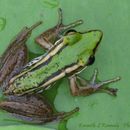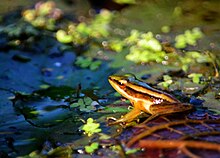en
names in breadcrumbs


The common green frog (Hylarana erythraea) is a frog species of in the true frog family Ranidae;[2] some sources still use the old name Rana erythraea. It lives in Southeast Asia and is also known as green paddy frog, red-eared frog or leaf frog.[1] The last name, however, commonly refers to the Neotropical tree frogs which make up the subfamily Phyllomedusinae. These are not closely related to H. erythraea, belonging to family Hylidae instead.
Long placed in Rana, it is only as closely related to this genus as is e.g. Amolops. Consequently, the genus Hylarana, of which the common green frog is the type species, warrants re-establishment. Hylarana seems to form a clade together with the similarly revalidated genera Pulchrana and Sylvirana, and presumably also Hydrophylax as well as some species presently placed in Pelophylax (e.g. Kokarit Frog, "P." lateralis).[3]
This frog has confused researchers for a long time, as it resembles tree frogs in habitus. It was initially placed in the tree frog genus Hyla. The junior synonyms of the common green frog are:
Male Hylarana erythraea grow to a snout–vent length of 30–45 mm (1.2–1.8 in) and females to 50–75 mm (2.0–3.0 in). Tadpoles are up to 36 mm (1.4 in) in length. They have smooth skin that is bright green above and on sides. Tympanum is distinct.[4]
H. erythraea occurs in Brunei, Cambodia, Indonesia, Laos, Malaysia, Myanmar, Singapore, Thailand, and Vietnam. Introduced populations are found on Sulawesi and the Philippines. The similar frogs from northeastern India and adjacent regions, formerly included here, are now separated as Hylarana tytleri.[1]
Its natural habitats are subtropical or tropical moist lowland forests, subtropical or tropical moist montane forests, freshwater lakes, intermittent freshwater lakes, freshwater marshes, intermittent freshwater marshes, rural gardens, heavily degraded former forest, irrigated land, seasonally flooded agricultural land, and introduced vegetation.[1]
 Common green frog on top of lilypads and other bog plants.
Common green frog on top of lilypads and other bog plants. The common green frog (Hylarana erythraea) is a frog species of in the true frog family Ranidae; some sources still use the old name Rana erythraea. It lives in Southeast Asia and is also known as green paddy frog, red-eared frog or leaf frog. The last name, however, commonly refers to the Neotropical tree frogs which make up the subfamily Phyllomedusinae. These are not closely related to H. erythraea, belonging to family Hylidae instead.
Hylarana erythraea[2] es una especie de anfibio anuro de la familia Ranidae.
Esta especie habita:
Se introdujo en Negros y Panay en Filipinas y Sulawesi en Indonesia.
Hylarana erythraea mide 78 mm para las hembras y 48 mm para los machos, los machos son más pequeños que las hembras. Su dorso varía de verde claro a verde oscuro, mientras que su vientre es blanquecino. Los pliegues dorsales son de color crema y algunas veces están bordeados con negro. Las extremidades son de color amarillento con rayas irregulares de color gris oscuro. Su piel es suave.
Hylarana erythraea Hylarana generoko animalia da. Anfibioen barruko Ranidae familian sailkatuta dago, Anura ordenan.
Hylarana erythraea est une espèce d'amphibiens de la famille des Ranidae[1].
Cette espèce se rencontre[1] :
Elle a été introduite à Negros et Panay aux Philippines et à Sulawesi en Indonésie.
Hylarana erythraea mesure au maximum 78 mm pour les femelles et 48 mm pour les mâles, les mâles restant plus petits que les femelles. Son dos varie du vert clair au vert foncé tandis que son ventre est blanchâtre. Les plis dorsaux sont de couleur crème et sont parfois bordés de noir. Les membres sont jaunâtres avec des rayures irrégulières gris foncé. Sa peau est lisse[2].
Hylarana erythraea est une espèce d'amphibiens de la famille des Ranidae.
Kongkang gading adalah nama sejenis kodok dari suku Ranidae. Nama ilmiahnya adalah Rana erythraea (Schlegel, 1837), yakni berasal dari nama sebuah kota kecil di Asia Tengah (Iskandar, 1998). Dalam bahasa Inggris, dikenal dengan nama golden-lined frog, green paddy frog, green lotus frog atau common greenback.
Kodok yang ramping dan berwarna hijau zaitun, hijau lumut atau hijau muda di punggungnya. Sepasang lipatan dorsolateral yang jelas, besar, berwarna kuning gading dan kadang-kadang disertai dengan garis hitam, terdapat di kiri kanan punggung. Tangan dan kaki berwarna kuning coklat muda, dengan coreng-coreng terutama pada paha. Sisi bawah tubuh berwarna putih. Kulit licin dan halus. Kodok jantan sekitar 30-45 mm, dan yang betina 50-75 mm.
Tangan dengan ujung jari melebar serupa piringan yang meruncing, yang terbesar sekitar setengah diameter timpanum (gendang telinga). Piringan pada jari kaki lebih kecil. Selaput renang mencapai pangkal piringan di jari-jari kaki, kecuali pada jari keempat yang memiliki dua ruas bebas dari selaput. Terdapat sekurangnya satu bintil metatarsal di kaki, yakni di sisi dalam.
Kongkang gading biasa ditemukan di kolam-kolam terbuka, tepi telaga, atau sawah; kadang-kadang didapati dalam kelompok agak besar. Lebih sering berada di air, kodok ini pada siang hari bersembunyi di antara vegetasi yang tumbuh di air yang dangkal atau di tepian. Dan malam harinya turun ke daratan di tepi air. Kerap berbunyi-bunyi di pagi hari, bunyinya seperti suara ceklikan: pik, … pik, pik, pik.
Kodok ini menyebar luas mulai dari Indochina, Jawa sampai ke Filipina, dan kemungkinan juga sampai Sulawesi.
(Inggris) Amphibian Species of the World 3.0, an Online Reference.
Kongkang gading adalah nama sejenis kodok dari suku Ranidae. Nama ilmiahnya adalah Rana erythraea (Schlegel, 1837), yakni berasal dari nama sebuah kota kecil di Asia Tengah (Iskandar, 1998). Dalam bahasa Inggris, dikenal dengan nama golden-lined frog, green paddy frog, green lotus frog atau common greenback.
Katak pisang ialah spesies katak daripada keluarga Ranidae. Nama saintifik katak ini (Rana erythraea) berasal dari nama sebuah bandar kecil di Asia Tengah (Iskandar, 1998).
Dalam bahasa Inggeris, Katak Pisang dikenali sebagai katak berlapis emas (golden-lined frog), katak sawah hijau (green paddy frog), katak teratai hijau (green lotus frog) atau common greenback. Katak Pisang dimasukkan ke dalam status Least Concern (risiko rendah) pada senarai merah IUCN. Katak Pisang boleh didapati di Asia Tenggara termasuk Malaysia, Kemboja, Laos, Indonesia, Brunei, Singapura, Thailand, Vietnam, Filipina, India dan Bangladesh.
Katak pisang ialah spesies katak daripada keluarga Ranidae. Nama saintifik katak ini (Rana erythraea) berasal dari nama sebuah bandar kecil di Asia Tengah (Iskandar, 1998).
Dalam bahasa Inggeris, Katak Pisang dikenali sebagai katak berlapis emas (golden-lined frog), katak sawah hijau (green paddy frog), katak teratai hijau (green lotus frog) atau common greenback. Katak Pisang dimasukkan ke dalam status Least Concern (risiko rendah) pada senarai merah IUCN. Katak Pisang boleh didapati di Asia Tenggara termasuk Malaysia, Kemboja, Laos, Indonesia, Brunei, Singapura, Thailand, Vietnam, Filipina, India dan Bangladesh.
Rana erythraea é uma espécie de anfíbio da família Ranidae.
Pode ser encontrada nos seguintes países: Brunei, Camboja, Indonésia, Laos, Malásia, Myanmar, Filipinas, Singapura, Tailândia e Vietname.[1]
Os seus habitats naturais são: florestas subtropicais ou tropicais húmidas de baixa altitude, regiões subtropicais ou tropicais húmidas de alta altitude, lagos de água doce, lagos intermitentes de água doce, marismas de água doce, marismas intermitentes de água doce, jardins rurais, florestas secundárias altamente degradadas, terras irrigadas, áreas agrícolas temporariamente alagadas e vegetação introduzida.[1]
Rana erythraea é uma espécie de anfíbio da família Ranidae.
Pode ser encontrada nos seguintes países: Brunei, Camboja, Indonésia, Laos, Malásia, Myanmar, Filipinas, Singapura, Tailândia e Vietname.
Os seus habitats naturais são: florestas subtropicais ou tropicais húmidas de baixa altitude, regiões subtropicais ou tropicais húmidas de alta altitude, lagos de água doce, lagos intermitentes de água doce, marismas de água doce, marismas intermitentes de água doce, jardins rurais, florestas secundárias altamente degradadas, terras irrigadas, áreas agrícolas temporariamente alagadas e vegetação introduzida.
Загальна довжина досягає 3—7,5 см. Спостерігається статевий диморфізм: самиці більші за самців. Відрізняється стрункою статурою, має виразні пластинки для прилипання на пальцях обох пар кінцівок. шкіра гладенька. Зверху зелена з металевим блиском, з боків темно-коричнева. Поздовжні складки спини у цієї жаби сріблясто-білі, барабанна перетинка червона. звідси походить назва цієї жаби. Черево білого забарвлення. Верхня половина райдужної оболонки золотаво-жовта, нижня вогняно-червона.
Полюбляє болотах, низовини, вологі гірські ліси, озера, рисові поля. Зустрічається на висоті 1200 м над рівнем моря. Активна вночі. Живиться комахами.
Сезонність в розмноженні не виражена. У самців зміни в інтенсивності сперматогенез у розвитку шлюбних мозолів протягом року незначні. У самиць також протягом усього року виявлено яйця на різних стадіях дозрівання. Проте відсоток самиць й самців, готових до розмноження, змінюється у різні місяці від 10 до 50.
Мешкає в Індокитаї, Малайзії, Брунеї, на островах Суматра, Ява, Калімантан, (Індонезія) Сулавесі, Негрос й Панай (Філіппіни).
Chàng xanh, tên khoa học Hylarana erythraea, là một loài ếch trong họ Ranidae. Chúng được tìm thấy ở Brunei, Campuchia, Indonesia, Lào, Malaysia, Myanma, Philippines, Singapore, Thái Lan, và Việt Nam.
Môi trường sống tự nhiên của chúng là các khu rừng ẩm ướt đất thấp nhiệt đới hoặc cận nhiệt đới, các khu rừng vùng núi ẩm nhiệt đới hoặc cận nhiệt đới, hồ nước ngọt, hồ nước ngọt có nước theo mùa, đầm nước ngọt, đầm nước ngọt có nước theo mùa, vườn nông thôn, các khu rừng trước đây bị suy thoái nặng nề, đất có tưới tiêu, đất nông nghiệp có lụt theo mùa, và thảm thực vật di thực.
Chàng xanh, tên khoa học Hylarana erythraea, là một loài ếch trong họ Ranidae. Chúng được tìm thấy ở Brunei, Campuchia, Indonesia, Lào, Malaysia, Myanma, Philippines, Singapore, Thái Lan, và Việt Nam.
Môi trường sống tự nhiên của chúng là các khu rừng ẩm ướt đất thấp nhiệt đới hoặc cận nhiệt đới, các khu rừng vùng núi ẩm nhiệt đới hoặc cận nhiệt đới, hồ nước ngọt, hồ nước ngọt có nước theo mùa, đầm nước ngọt, đầm nước ngọt có nước theo mùa, vườn nông thôn, các khu rừng trước đây bị suy thoái nặng nề, đất có tưới tiêu, đất nông nghiệp có lụt theo mùa, và thảm thực vật di thực.
Hylarana erythraea (Schlegel, 1837)
СинонимыКрасноухая лягушка[1] (Hylarana erythraea) — вид земноводных из семейства настоящих лягушек.
Общая длина достигает 3—7,5 см. Наблюдается половой диморфизм: самки крупнее самцов. Отличается стройным телосложением, имеет выразительные пластинки для прилипания на пальцах обеих пар конечностей. Кожа гладкая. Окраска сверху зелёная с металлическим блеском, по бокам тёмно-коричневая. Продольные складки спины у этой лягушки серебристо-белые, барабанная перепонка красная (отсюда происходит название этой лягушки). Брюхо белого цвета. Верхняя половина радужной оболочки золотисто-жёлтая, нижняя — огненно-красная.
Любит болота, низменности, влажные горные леса, озёра, рисовые поля. Встречается на высоте 1200 метров над уровнем моря. Активна ночью. Питается насекомыми.
Сезонность в размножении не выражена. У самцов изменения в интенсивности сперматогенеза в развитии брачных мозолей в течение года незначительны. У самок также в течение всего года обнаружены яйца на разных стадиях созревания. Однако процент самок и самцов, готовых к размножению, меняется в разные месяцы от 10 до 50.
Обитает в Индокитае, Малайзии, Брунее, на островах Суматра, Ява, Калимантан (Индонезия), Сулавеси, Негрос и Панай (Филиппины).
Красноухая лягушка (Hylarana erythraea) — вид земноводных из семейства настоящих лягушек.
Общая длина достигает 3—7,5 см. Наблюдается половой диморфизм: самки крупнее самцов. Отличается стройным телосложением, имеет выразительные пластинки для прилипания на пальцах обеих пар конечностей. Кожа гладкая. Окраска сверху зелёная с металлическим блеском, по бокам тёмно-коричневая. Продольные складки спины у этой лягушки серебристо-белые, барабанная перепонка красная (отсюда происходит название этой лягушки). Брюхо белого цвета. Верхняя половина радужной оболочки золотисто-жёлтая, нижняя — огненно-красная.
Любит болота, низменности, влажные горные леса, озёра, рисовые поля. Встречается на высоте 1200 метров над уровнем моря. Активна ночью. Питается насекомыми.
Сезонность в размножении не выражена. У самцов изменения в интенсивности сперматогенеза в развитии брачных мозолей в течение года незначительны. У самок также в течение всего года обнаружены яйца на разных стадиях созревания. Однако процент самок и самцов, готовых к размножению, меняется в разные месяцы от 10 до 50.
Обитает в Индокитае, Малайзии, Брунее, на островах Суматра, Ява, Калимантан (Индонезия), Сулавеси, Негрос и Панай (Филиппины).